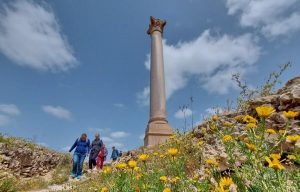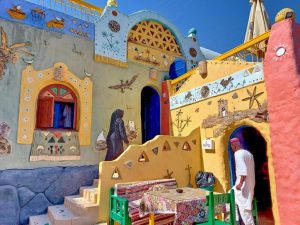The Royal Jewelry Museum is a two-story home that belonged to Princess Fatma Al-Zahraa, an Egyptian Royal family member, and was decorated to her liking in 1920. With burgundy plush, deep carpets, and carved, gilded ceilings, an entryway is a magnificent event. A small flight of marble steps leads to the first level from here.
The walls are adorned with portraits of all the royal descendants of the Mohamed Ali Dynasty (along with a brief description). Except for her obviously outstanding sense of home decorating, little is known about Princess Fatma’s life and background.
The rooms on both floors are crammed with exhibit boxes showing every conceivable object of prestige, elegance, and wealth. The royal crowns and tiaras are the most essential pieces in the collection. The platinum tiara and matching earrings stand out from the rest of the ensemble. The tiara belonged to King Fouad’s wife and was studded with 2,159 first-grade diamonds and valuable white pearls.
King Farouq’s personal toilet set is also not to be missed. Huge crystal bottles with hefty gold lids and the royal coat of arms delicately perched on a gold tray make up the set.
The interior decorating, rather than being dazzled by the sheer number and expertise of craftsmanship of the jewelry discovered in the home, is more remarkable. Unlike the majority of the royal family’s private houses in Egypt, which are often dominated by Islamic tastes in design and décor, this villa is entirely influenced by European aesthetics.
Every room’s ceiling was hand-painted by Egyptian, Italian, and French artisans. Some of the second-floor ceilings feature scenes from Greek mythology, but the majority depict scenes from classic French and Italian love stories, painted in vibrant colors. The villa’s walls are either paneled in oak or chestnut wood or painted with massive scenes from French medieval stories.
On all floors, the bathrooms are genuine pieces of beauty. The halls and toilets are all lined with tiny white porcelain pieces from Sevres, a renowned French porcelain company. Swimming nymphs, pictures from the well-known Fables of La Fontaine, and fairytales are hand-painted on white backgrounds with brilliant colors on the walls of the two big bathrooms.
The stained glass panels in the main hall of the first floor, the stairway, and the first-floor bathroom, however, are the villa’s centerpiece. These masterpieces, which tell the story of great European love stories, were commissioned by prominent French artists of the time. Unfortunately, the property had been stripped of its previous owner’s possessions and furniture. It would have been fascinating to see how the Princess would have decorated such a home. The garden is not large, but it is well-kept. At a reasonable price, the tiny well-stocked souvenir shop sells cards, books on various times of Egyptian history, and brilliantly colored gift items.
The Royal Jewelry Museum is open Monday through Friday from 9 a.m. to 4 p.m., except Fridays, when it is open from 10 a.m. to 11.30 a.m. and 1.30 p.m. to 4 p.m.










